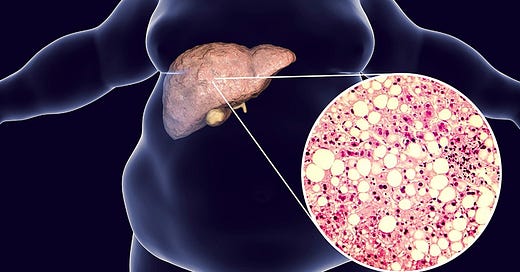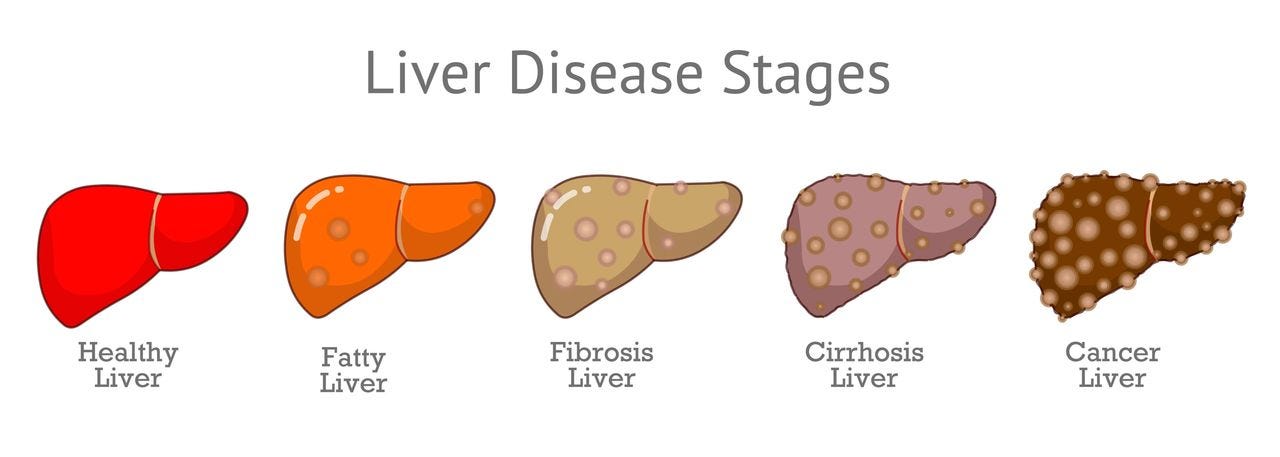Chasing & filing blood tests can be a pain. It's all good when it's nice and easy but when there is a rare abnormality it can really slow you down.
Common (frustrating) scenarios include fertility bloods, auto-antibodies and of course, LFTs.
We worry about LFTs for a number of reasons but recently, non-alcohoic fatty liver disease (NAFLD) has become big news. The global prevalence of NAFLD is approximately 25% and as well as fibrosis, these patients are also more likely to suffer complications of diabetes, renal failure and cardiovascular disease’. The rate of cancer is also higher in such patients. In summary, it is a terrible disease that is become more and more prevalent in the UK population.
So here are some key points we should all be aware off when spotting that classically raised ALT:
NAFLD is concerning because of the spectrum of progression. It can lead to Nonalcoholic steatohepatitis (NASH) which involves inflammation in the liver as well as fibrosis. This leads to liver cirrhosis.
It’s likely that NAFLD will come to be known as MAFLD (metabolic associated fatty liver disease) so that it is better managed and escalated in light of other co-morbidities such as diabetes and high cholesterol.
How do we risk stratify these patients? Liver biopsy is the gold standard but is costly and time consuming. Therefore, we use the following tools:
ALT - This detects generalised liver surface inflammation
Fibrosis-4 (fib-4) index - This takes the age, ALT:AST ratio and platelets to determine global liver function/impairment.
ELF score - This is often done if the above tests are raised. It looks at a series of metalloproteinases and peptides associated with fibrosis.
Transient elastrography (Fibroscan) - This is an ultrasound scan that measures liver stiffness and therefore predicts the extent of fibrosis.
So how should we manage these patients?
Treat metabolic syndrome: calculate a QRISK score and optimise hypertension and diabetic control.
Drugs - currently there are no specific drugs although some really exciting drug trials are taking place. Some of these include:
Vitamin A supplementation
Pioglitazone (anti-diabetic drug)
Peroxisome proliferator-activated receptor (PPAR) antagonists. These receptors have been found to be principally involved in fibrotic tissue formation.
So that’s all. Hopefully you’re all up to date with NAFLD. Until next time!
What Am I Watching?
Slightly retro but I’m actually watching some of my favourite episodes of Friends again. Most people who know me think that my personality is closest to Chandler (odd jokes etc), and I was quite saddened to hear about the death of Matthew Perry who played him.
Who’s your favourite Friends character?
Want to Master Blood Interpretation?
Lots of you asked if we could run a blood interpretation session so we’ve done just that! Join us this Sunday (3/12/23) from 10:00-13:00 where we will discuss GI investigations interpretation.
This online, CPD accredited webinar will cover:
Core abdominal bloods including LFTs,
Fatty liver disease and non-invasive liver screen interpretation
intra and extra-hepatic jaundice including biliary pathology
hepatitis serology & tumour markers
Drug induced hepatitis and cholestatis
Key tests including - amylase, FIT, calprotectin and much more!
So be sure to not miss out and sign up now!
Check us out on our various pages:
Website: www.paretoeducation.co.uk
Instagram: https://tdy.lol/lQSxv
TikTok: https://tdy.lol/AJdzQ
YouTube: https://tdy.lol/ZEoOt
Newsletter: https://tdy.lol/WnTBR
LinkedIn: https://tdy.lol/efLOB







